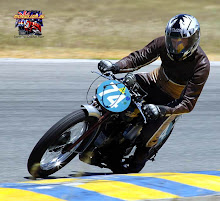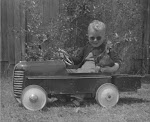Darn Pilgrims and Other Stories from the High Country
A Snapshot from Day 5 of the VOCNA 2001 Summer Ride: Gunnison, Colorado.
On SBS TV there is a show called “Front Up”. The recipe is simple – take one non-confronting journo (Andrew Urban), one sound man, one camera man. Walk up to people in the street at random and start talking. The premise of the show is very sound – real life is stranger than fiction. In general, Andrew takes less than a minute to have his interviewee relax and begin to open up on national TV. Very little editing is used.
Classic subjects include the guy who owned a 60 ft yacht, but couldn’t cruise the world as planned because he was going through a bitter divorce and the yacht was part of the disputed settlement. But he’d led an interesting life and during he course of a ten minute chat revealed:
· that he’d once fallen 50 feet down a cliff while abseiling, broken his back, nearly died from head wounds and loss of blood, but during the night whilst a search and rescue party was being assembled, a heavenly vision visited upon him. After this, he arose and walked out through dense bush unaided.
· that his love partners have been known to levitate during the act.
· that he has mystical powers enabling him to locate opals in the ground. As a result, as a teenager he made a small fortune working the mining leases of White Cliffs.
Another classic subject was assisting her partner selling tropical fruit and coconuts at an open air market in Darwin. But during the first minute of discussion when Andrew asked what she did when the markets were closed, she revealed that she was a bondage mistress. She found this paid a far better hourly rate than teaching. She also revealed that her best clients were from the local military base, and they always demanded tougher treatment and tighter strapping of the various tools of her leathery trade than any other occupational group. Must be something related to events during their training, she mused. Most enlightening for we, the vast ‘vanilla’ viewing population Down Under.
Which brings me to a particular event on day 5 of the VOCNA Colorado bash, Friday 3rd August 2001. It was like Front Up, but in reverse.
As I recall it, Kitey and I had just stormed another mountain range, dispensed with a few cars on the climb, but had more trouble dispensing with a mad bugger in a Hyundai Sonata (must have been a rental) on the descent. He wasn’t quick enough through the corners but he was flooring it along the short downhill straights – how do you safely pass a guy doing 80 when there’s another switchback approaching rapidly? I don’t exactly remember how, but we both slipped by and ran to the bottom with the road to ourselves, another memorable part of our motorcycling that week.
Then we got into some high plains country, heading toward Gunnison. Kitey stopped (possibly a nature call), but I continued, taking a couple of “rider’s view” photos to pass the time – relatively easy with camera stowed in a zippered pocket on the tankbag and with these long, straight, deserted roads. By the way, don’t ever look down the view finder as you would for static photography, as this can lead to the machine taking an unintended course (I discovered this over 20 years ago, and fortunately corrected the course just in time). Just hold the camera one handed, point in the general direction and be prepared to throw away the dud pics.
I reached the outskirts of Gunnison just on lunch time. There was a neat and tidy park on the right with shade trees and a couple of bikes parked. I pulled in to chat with the riders (Debbie McDonald and Sue Ray) and wait for Kitey, and Richard who was tailing us both (unless he’d found a shortcut). Debbie and Sue left to see if Sue’s husband John was in town having a feed. I waited, stripping off my jacket and placing it on a patch of shaded grass. Before I could lie down, it happened.
A raucous Triumph twin roared up from the direction of Gunnison down town. It wheeled in towards the kerb, coming to a halt behind the borrowed Courgette (the aging, strong-hearted D’Orleans Thruxton). Its Roadrunner-capped rider dismounted and walked over. Within a minute of the discussion starting, I realised what was going on. I had been accosted in the town park by a 59 year old, bearded, Triumph-riding native of Gunnison Colorado, the irascible, irrepressible, and at times irritable, DC Trip (“Dee Cee, as in current” he said.) This definitely felt like Front Up in reverse.
Unfortunately, DC had an unnerving habit of moving forward, puffing out his chest and invading the listener’s personal space whenever the subject matter aroused his emotions. But I’m a good listener so the conversation continued. Aside from sharing an appreciation of old bikes, this manic character told me many stories about his life in this remote town – reputed to have the highest gun ownership per capita of any town in the USA and home of the highest tertiary institution in the USA, Western College.
I noticed a Vincent badge on his cap and asked if he had owned one. “I used to ride a Vincent to West’n College in 1958. It had open pipes, Lightning cams and man, it used to go-o-o! I sure showed those darn pilgrims in their ‘57 Chevy’s who was boss!” He then explained how he had a Featherbed frame at home which was still waiting for a Vincent engine. About 3 years ago he’d read about the new Vincent, the RGV, which some Sydney based Aussies were going to produce. DC had been in touch by e-mail and all but placed an order for one of the first production engines when the whole project failed. He was not happy about this. The memory of the disappointment aroused his emotions. I wonder if he’s sussed out where I’m from, I thought, as he moved into my personal space with chest puffed out. “Damn east coast Aussies” I said, quickly dissociating myself from anyone east of Kalgoorlie (easily done for a recently converted West Australian, especially when feeling threatened).
His granpappy taught him the art of fly fishing in the Black Canyon of the Gunnison River (a spectacular place with sheer cliffs rising 1800 feet from the river bed). One day DC took the bamboo rod his granpappy had made in 1927, and rigged it with one of his own special flies. “They all wanna know what I put in maa lures but I won’t tell those damn pilgrims. But aa’ll tell you. I use those h-u-u-ge bugs that you saw when you were ridin’ into town – you know the ones that ya hit and they stop ya dead in yer tracks!” On this particular trout fishing sortie, DC spotted a 9lb trout and skilfully flicked the fly within striking distance. But just before the trout struck, a passing bird swooped on the fly. “Then that big ol’ trout leaped out of that river, grabbed the bird and the fly, and as he dis’peared under the water I could see the wings stickin’ out o’ the sides o’ his mouth!” Could this be a Rocky Mountains legend, akin to the many urban legends of our cities? Don’t know, but until I hear the same story from another source, I’ll give DC the benefit of the doubt.
At about the time this chapter of the story began, Kitey and Richard rode up, dismounted, came over to meet my new acquaintance, but were generally ignored. They stood back a respectable distance, assessed the situation then after a few minutes departed with the words “See ya mate – we’re just heading into town to grab some lunch!” Thanks for your moral support mates – you soon find out who you can count on in a time of need, don’t you.
Conversation then moved to my destination that day, Crawford, which was west on 50 then north on Highway 92. “That Highway 92, that’s maa road. Man its got broken edges ‘n potholes ‘n blind corners with a sheer drop off the edge – one mistake and yerr gone. But me ‘n maa ol’ Triumph, we know every inch of that road. An’ ya know those darn pilgrims on their Japanese Soooperbaaks, they come up here on weekends, thinkin’ they can ride fast, and they can’t ride fer nuts. Why last week I was ridin’ up 92 as they was pullin’ one of those green merchines out of the Black Canyon on the end of a wire rope, with the bike bangin’ ‘n bumpin’ all the way to the top. The previous day they pulled the rider out o’ that same Canyon ‘n put ‘im in a bag.” I enquired further as to the particular hazards I might face. “Trouble is, if it’s bin rainin’, the sand washes off o’ the banks ‘n out onto the road on some o’ them blind corners. An’ ya gotta look out fer deer, ‘n stay away from those broken edges or else ya could end up in the Canyon like that green merchine.”
At this point I felt decidedly peckish, having visions of my (former) mates tucking into a hearty lunch at a down town diner. The only way I could distract the conversation was to ask for a photo of DC standing next to his Triumph. “Nice Triumph, that – do you mind if I take a photo?” At this, DC wheeled around, paced over to the bike, making guttural sounds, and then spat on it, vehemently. “Man this bike is NUTHIN’ – you should see maa 62 Bonnie – now that’s a re-e-l nice Triumph.” Despite this outburst, I got my shot of DC standing proud, with his Triumph in front and, at his specific request, included the hillside behind with its monstrous capital W in white. “That stands fer West’n College – that’s maa ol’ college.” At that point I bade him farewell.
Where is Andrew and the SBS Front Up crew when you need them? Real life really is stranger than fiction, especially in Gunnison, CO. QED.












